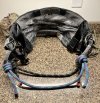-
The SH Membership has gone live. Only SH Members have access to post in the classifieds. All members can view the classifieds. Starting in 2020 only SH Members will be admitted to the annual hunting contest. Current members will need to follow these steps to upgrade: 1. Click on your username 2. Click on Account upgrades 3. Choose SH Member and purchase.
-
We've been working hard the past few weeks to come up with some big changes to our vendor policies to meet the changing needs of our community. Please see the new vendor rules here: Vendor Access Area Rules
You are using an out of date browser. It may not display this or other websites correctly.
You should upgrade or use an alternative browser.
You should upgrade or use an alternative browser.
How to tie on a bridge
- Thread starter justsomedude
- Start date
justsomedude
Well-Known Member
justsomedude
Well-Known Member
Two knots like this in webbing reduces the total length about 30" (I don't make my loops small)
IkemanTX
Well-Known Member
- Joined
- Oct 16, 2015
- Messages
- 3,501
Two knots like this in webbing reduces the total length about 30" (I don't make my loops small)
What knot is that? Is it just an overhand or an overhand on a bight? I was just sitting down trying to figure out how to tie a good, safe knot to both ends of the Sit Drag without a lot of twisting.
Sent from my iPhone using Tapatalk
justsomedude
Well-Known Member
It becomes an Overhand on a bight after you retrace it. It is a tried and trusted climbing knot used for making anchors around trees
IkemanTX
Well-Known Member
- Joined
- Oct 16, 2015
- Messages
- 3,501
It becomes an Overhand on a bight after you retrace it. It is a tried and trusted climbing knot used for making anchors around trees
How did you tie the second one without being able to wrap the bight due to the Sit Drag and bridge combo being a full circle?
Sent from my iPhone using Tapatalk
justsomedude
Well-Known Member
You tie both loops in place around the SitDrag.
Just follow the pics above. It's so simple that when I finally got it I laughed
Just follow the pics above. It's so simple that when I finally got it I laughed
justsomedude
Well-Known Member
But the way... you can do the same thing with a Figure 8
DIYSaddler
Well-Known Member
- Joined
- Jul 22, 2015
- Messages
- 632
The water knot is fine for webbing but you should use a figure8 or a tripple fishermans loop for a rope bridge.
IkemanTX
Well-Known Member
- Joined
- Oct 16, 2015
- Messages
- 3,501
The water knot is fine for webbing but you should use a figure8 or a tripple fishermans loop for a rope bridge.
Technically, this is the exact same final knot as an "overhand on a bight" which is rescue rated. He just used a retrace technique to get it done since he didn't have a free tail to loop through for the overhand. I used the overhand on a bight two seasons in a row without any noticeable loss of tails. Although "technically" a slipable knot, I haven't noticed any slippage. Long tails and frequent checks and it should be very safe.
Sent from my iPhone using Tapatalk
justsomedude
Well-Known Member
I am NOT a climbing expert. But I have friends that are. General consensus is that yes, a Fig 8 is stronger. But the knot isn't the weak link in this equation.
Your sit drag will pop WAY before my bridge will.
They mainly use the Fig 8 when they know they have enough rope and space to fit the knot and they know it is going to get loaded and they want to be able to easily untie it afterwards.
Your sit drag will pop WAY before my bridge will.
They mainly use the Fig 8 when they know they have enough rope and space to fit the knot and they know it is going to get loaded and they want to be able to easily untie it afterwards.
justsomedude
Well-Known Member
Bump
pinebarens
Active Member
- Joined
- Sep 17, 2017
- Messages
- 103
Thanks just some dudeOverhand Knot on a Bight Retrace
First, tie an overhand on a bight so you know how much material you need.
View attachment 1590
Then untie the knot and tie an overhand knot where your original knot started
View attachment 1591
Feed the tag around your loop
View attachment 1592
Now just retrace the knotView attachment 1593 View attachment 1594
davesonic444
Member
- Joined
- Oct 2, 2016
- Messages
- 87
David Toms has a youtube video of the webbing he called an adjustable bridge. I am using it (water knot) to get the finale length i want for my bridge.
Jason Radisson
New Member
- Joined
- Aug 21, 2023
- Messages
- 1
FWIW as this is an old thread, I'm using a buntline finished with a half hitch. There have been some good videos posted on the topic of cinching termination hitches since this thread. Hope this helps anyone who's searching for info tying a fixed bridge on a saddle. JR
Last edited:
Evidently inspection is necessary throughout use; but initially, climbing industry "spec" requires that the length of any tag end of a knot be at least 5x the rope diameter. I.e. a 13mm rope should have a minimum 65mm (2.6") tag end exiting the knot. These lengths also are after fully "dressing" the knots.
Do your own research lol. Don't just take my word for it!
Do your own research lol. Don't just take my word for it!










